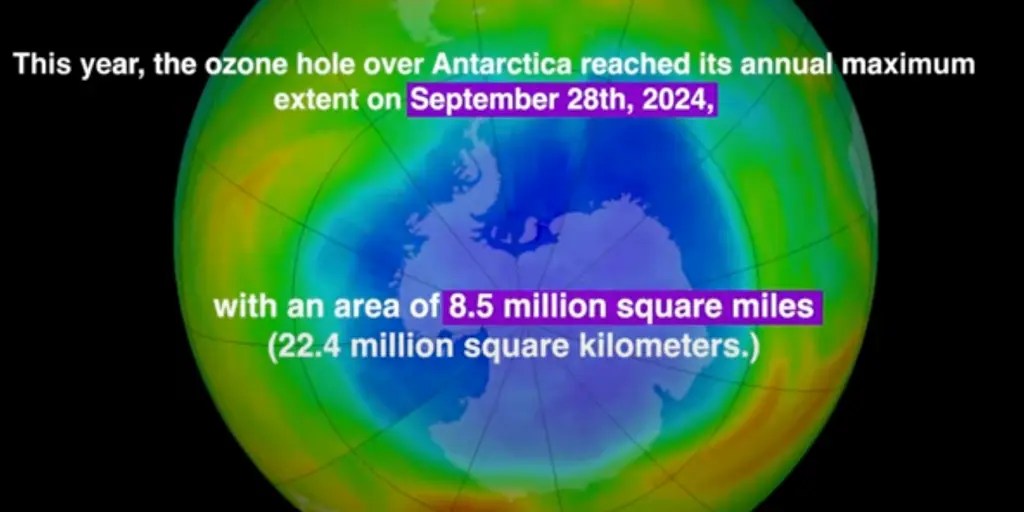By Steve Goreham
“In 2015, scientists at NASA predicted that the Ozone Hole would be half closed by 2020. That hasn’t happened. Other scientists have forecasted that the hole will not begin to disappear until 2040 or later. But the longer the hole persists, the greater the likelihood that the ozone layer is dominated by natural factors, not human CFC emissions.”
Another year has passed, and that stubborn Ozone Hole over Antarctica refuses to go away. Data from the National Aeronautics and Space Administration (NASA) shows that the area of the Ozone Hole remains about the same as it has been over the last 30 years. But will scientists admit that they didn’t save the ozone layer?
Background
Ozone is a gas made up of three oxygen atoms (O3). Ninety percent of the ozone in the atmosphere is found in the stratosphere, a layer of atmosphere between about 10 and 50 kilometers in altitude. The amount of ozone in the atmosphere varies with time of year.
Dr. Mario Molina and Dr. Sherwood Rowland of the University of California published a paper in 1974 warning that industrial chlorofluorocarbon (CFC) pollution was destroying the ozone layer in Earth’s stratosphere. CFCs were gases used in hair spray, refrigerators, and insulating foams.
The theory of Molina and Rowland postulated that CFCs from human industry move upward through the atmosphere to the stratosphere, where ultraviolet radiation breaks down CFC molecules, releasing chlorine atoms. Chlorine then acts as a catalyst to break down ozone molecules into oxygen, reducing the ozone concentration. According to the theory, the more CFCs consumed, the greater the destruction of the ozone layer.
In 1983, researchers from the British Antarctic Survey discovered a thinning of the ozone layer over Antarctica which occurred during August, September, and October. This became known as the Ozone Hole. This appeared to confirm the theory of Molina and Rowland, who were awarded a Noble Prize in chemistry in 1995 for their work.
Montreal Protocol (1987)
The ozone layer blocks ultraviolet rays, shielding the surface of the Earth from high-energy radiation. According to scientists, degradation of the layer would increase rates of skin cancer and cataracts and cause immune system problems in humans. In Earth in the Balance (1992), Al Gore claimed that hunters reported finding blind rabbits in Patagonia and that fishermen were catching blind fish due to human destruction of the ozone layer, but this was not confirmed.
In 1987, 29 nations and the European Community signed executed the “Montreal Protocol on Substances that Deplete the Ozone Layer”. Over the next decade, signers of the treaty rose to over 180 nations, all agreeing to ban the use of CFCs.
Because of the Montreal Protocol ban, world consumption of ozone depleting substances (ODS), or chlorofluorocarbons, began falling in 1990. By 2005, ODS consumption was down 90 percent and is now down more than 99 percent, according to the European Environment Agency.
Result?
The Montreal Protocol was hailed as an example of international success of how nations could unite to resolve a major environmental issue. The Protocol has been praised as an example to follow for elimination of greenhouse gas emissions in the fight to halt global warming. But despite the elimination of CFCs, the Ozone Hole remains as large as ever.
NASA reported this fall that the mean ozone hole area for September 7 to October 13 again reached 23 million square kilometers, roughly the same level as in the last three decades stretching back to 1994–1995. The hole remains large, despite that fact that world ODS consumption has almost been eliminated.
In 2015, scientists at NASA predicted that the Ozone Hole would be half closed by 2020. That hasn’t happened. Other scientists have forecasted that the hole will not begin to disappear until 2040 or later. But the longer the hole persists, the greater the likelihood that the ozone layer is dominated by natural factors, not human CFC emissions.
___________________
Steve Goreham is a speaker on energy, the environment, and public policy and the author of the bestselling book Green Breakdown: The Coming Renewable Energy Failure. His recent Wall Street Journal op-ed, If Green Energy Is the Future, Bring a Fire Extinguisher, brought national attention to the lithium battery problem.
Related


